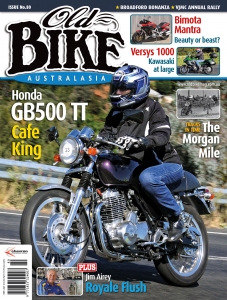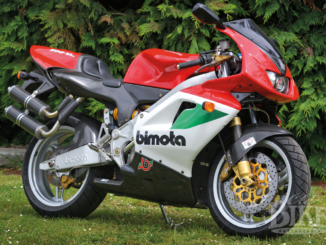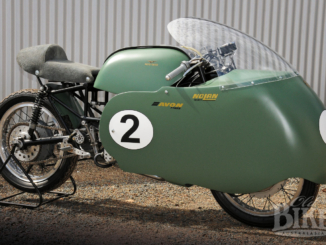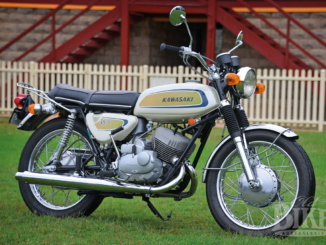
From our Old Bike Archives – Issue 80 – first published in 2019.
Story: Nick Varta • Photos: Jim Scaysbrook
In Sanskrit, Mantra means ‘instrument of thought’, and Bimota’s version certainly promotes plenty of thought.
There’s no half-measures with the Bimota Mantra. You either love it or loathe it. The design can only be described as radical, and when you consider it carried the badge of Bimota, known for stylish and svelte racing and sports motorcycles, this was a leap into the unknown. But the look of the Mantra is not surprising once you consider that it was penned by Sacha Lakic; Serbian-born, Paris-bred; a designer who has pushed the envelope ever since he picked up a pen, or a lump of modelling clay.

Back in 1986, Lakic co-designed the Yamaha-FZ750 powered Axis 749, and there are clearly traces of what became the Bimota Mantra in that exercise. At the time Lakic was working for Paris-based design studio Alain Carré; concepts that were transformed into metal by Boxer Bikes, based in Toulouse. One of the Boxer creations, the Triumph Daytona-engined Gladiateur, was displayed at the 1993 Paris Motorcycle Show, where it was heavily scrutinised by Bimota’s Auriello Lolli, who began discussions with its designer with a view to taking his talents to Bimota, which he did. It was heralded as being the kick-off in an enduring relationship, which it wasn’t.
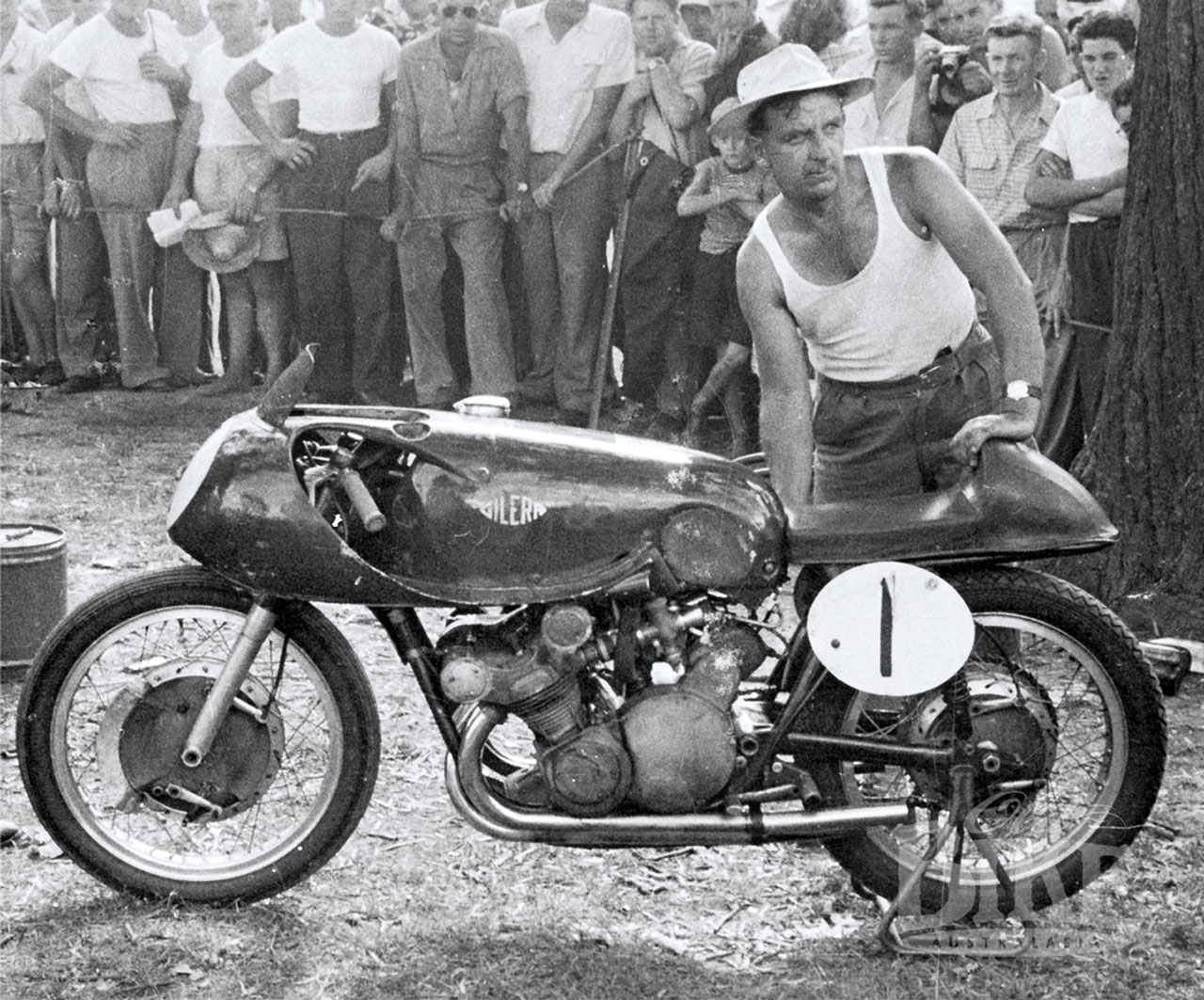
Lakic says his thinking behind the Mantra concept was influenced by the early Italian Rumi racers with their all-enveloping streamlined fuel tanks (which were also a feature of the mid’ 50s Gilera 4 works racers). Also in 1986, Yamaha took a major stake in the company that had originally been Motobécane, which was renamed MBK, with the emphasis on small capacity scooters. By 1988 Lakic was with MBK, and penned the Black Cristal, a scooter with an F1-insired carbon fibre monocoque chassis which became much imitated following its sensational debut at the 1993 Paris Salon. The fanfare led Lakic to branch out on his own, and one of the first customers to come knocking on the door of his Paris studio was Bimota.
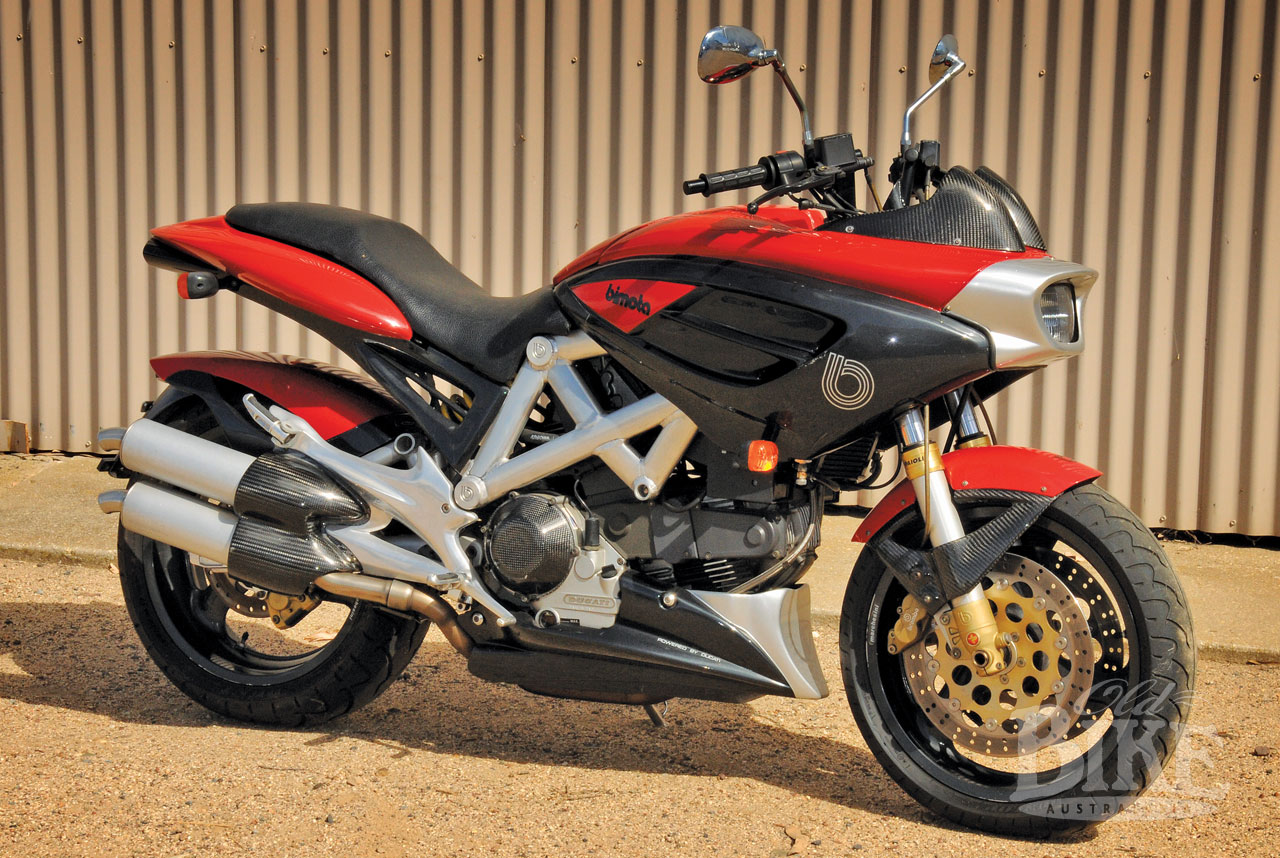
The Rimini company already had the basis for its new DB3 project, and Lakic’s role was to be limited to the styling of the bodywork, while the chassis was the work of Bimota’s celebrated engineer Pierluigi Marconi, who had the Bimota Tesi to his credit. This was to be the first Bimota not clothed in a fairing, so it was essentially a blank canvass for Lakic. Previously, Bimota had specialised in tubular steel frames, but the model that became the Mantra was made from oval-section aluminium, welded together in trellis fashion and using the engine/gearbox unit as a semi-stressed chassis member. The structure tipped the scales at a scant five kg. The same basic chassis was used for the Bimota BB1 Supermono which used a 652cc Rotax single cylinder engine, as also used on the BMW F650. The swinging arm, made up from square and round sections, connected directly to a single Paoli rear shock absorber that was offset to the right in order to clear the rear cylinder head, and pivoted directly in the crankcases of the 904cc Ducati engine. A 43mm Paoli front fork sat up front. The three-spoke Marchesini alloy wheels were Ducati 900SS stock, with Brembo Goldline four-piston callipers acting on twin 320mm full floating cast iron discs (with braided brake lines), with a two-piston calliper on a 230mm rear disc.
The Mantra’s engine was also plucked straight from the Ducati 900SS, the unit having also powered the Bimota SB2. With twin 38mm Mikuni carburettors fitted, this produced 86 bhp at 7,000 rpm, with 90 Nm of torque at 5,500 rpm – hardly scintillating stuff but adequate for the purpose.
During 1994, Lakic beavered away at the Bimota factory, producing a mock up in modelling clay with the deadline set for October of that year at the Motorcycle Show in Cologne, Germany. It’s true to say that the Mantra, when the drapes were pulled back on the Bimota stand, drew a mixture of sighs of admiration and gasps of horror. Like the Rumi or Gilera that had inspired him, Lakic’s design had the upper bodywork running from the rectangular headlight, which was recessed into the nose cone, all the way back to the seat, with the steering head completely enclosed. The fuel tank itself was split into two ‘pods’, one half on each side plus a central channel, with a small lockable compartment in the rear of the tank in front of the seat. Originally this compartment was scarcely large enough to hold a handkerchief, but in production form it was enlarged sufficiently to accommodate a folded wet weather top or spare gloves.

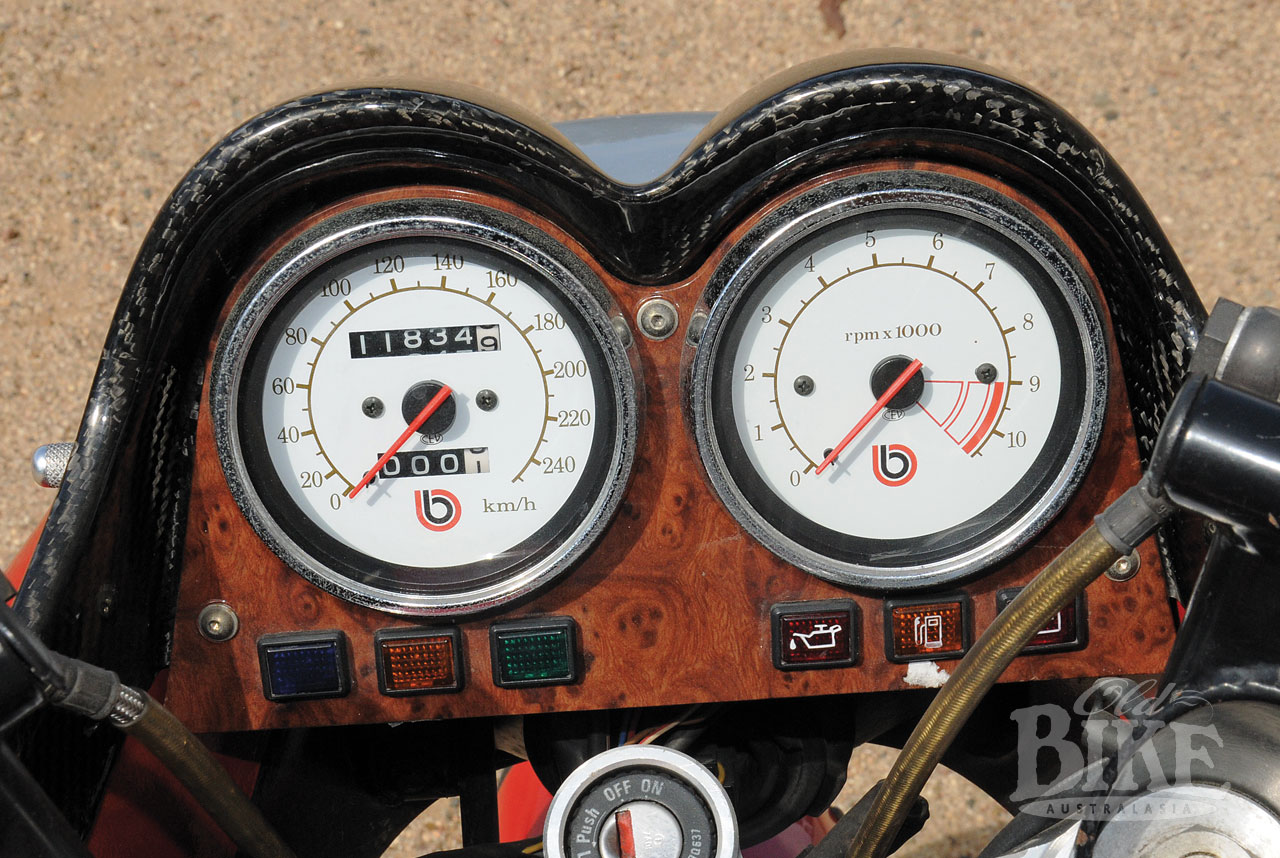
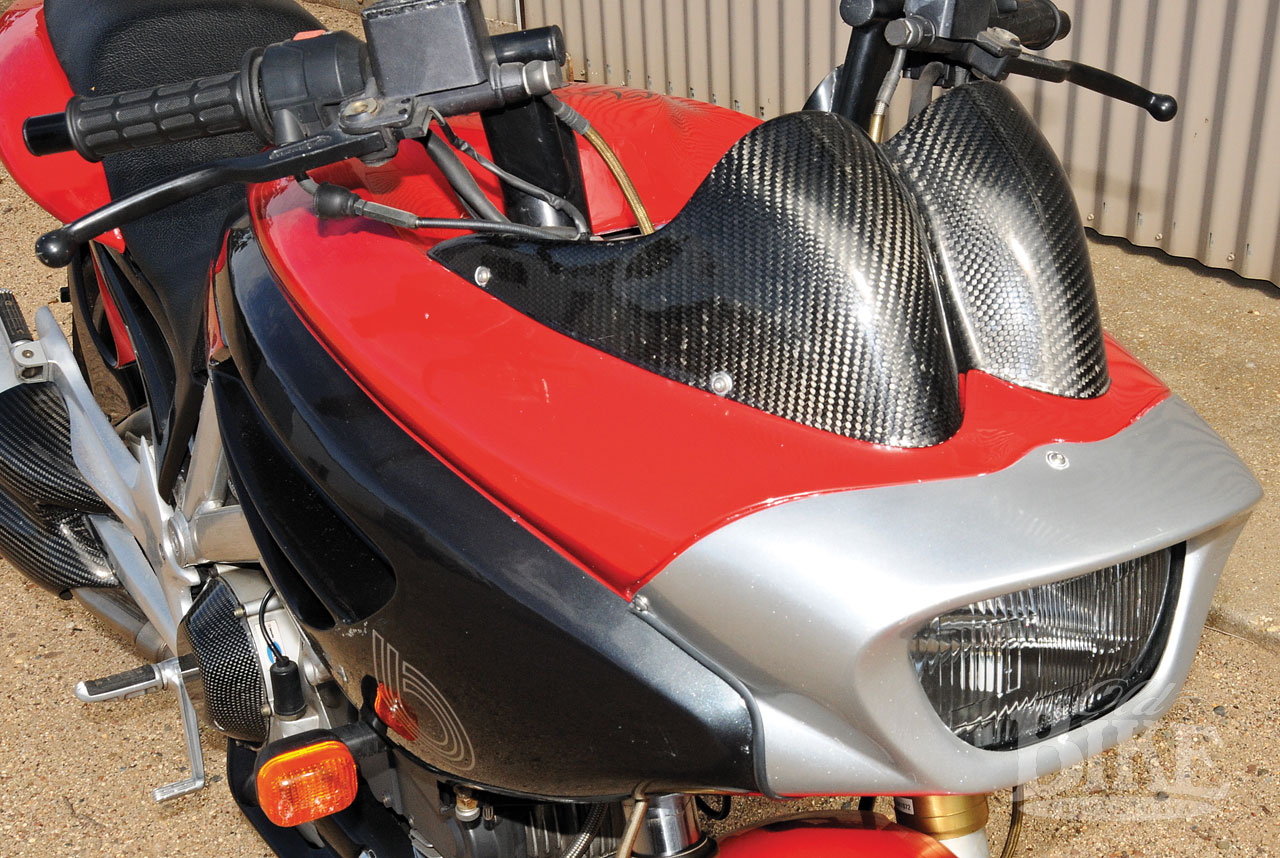
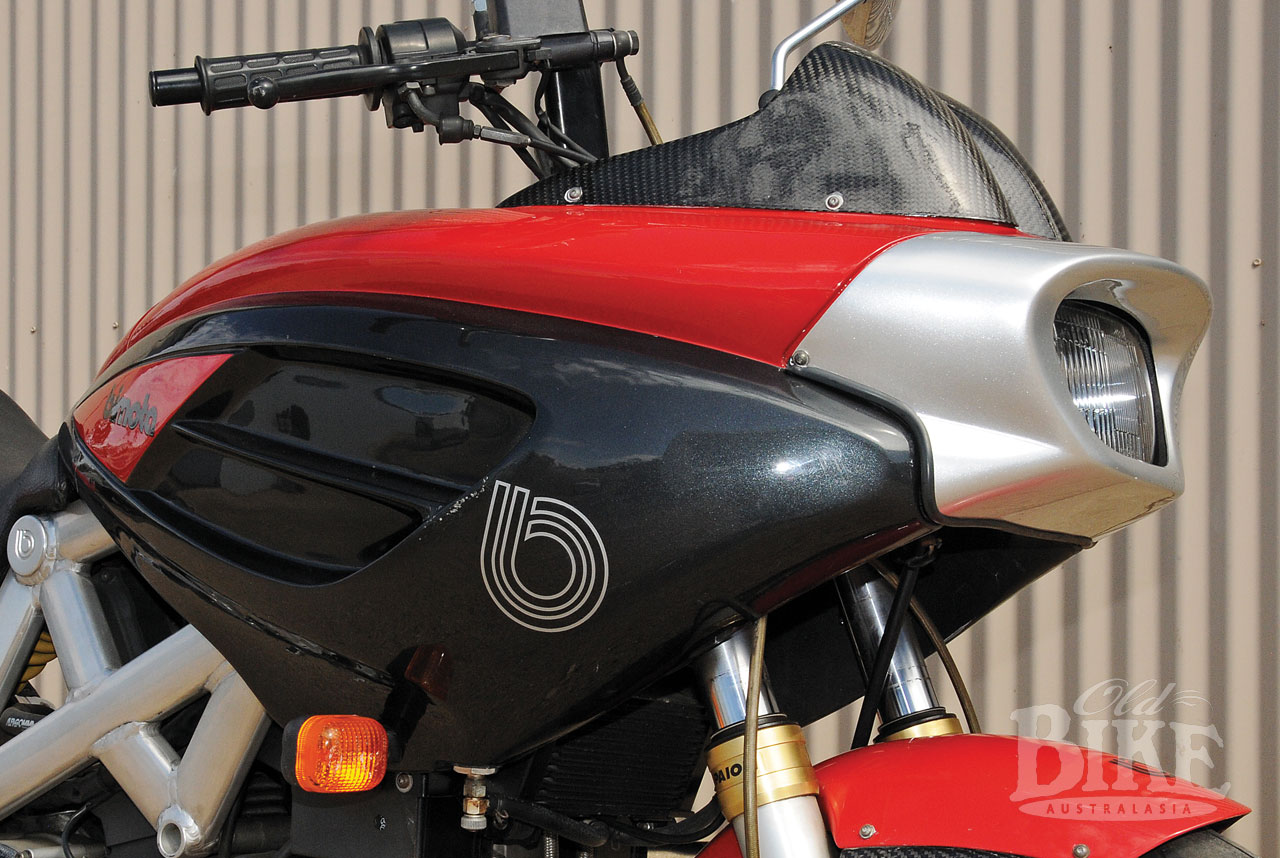
Shielding the twin instruments was a pair of carbon fibre shrouds; the high-tech material in stark contrast to the very British dashboard fascia finished in a plastic mock-teak that looked like it had come from a ‘fifties Rover. It’s the equivalent of a beige Terry Towelling steering wheel cover on a Ferrari. The dashboard itself housed small rectangular lights for indicators, neutral gear position, oil warning, low fuel level, battery and high beam. Indeed, from a rider’s perspective, the Mantra presented an odd view, with the handlebars mounted high on cast alloy risers secured to the fork caps above the milled aluminium top fork yoke. A detachable windscreen was listed as a very sensible optional extra.
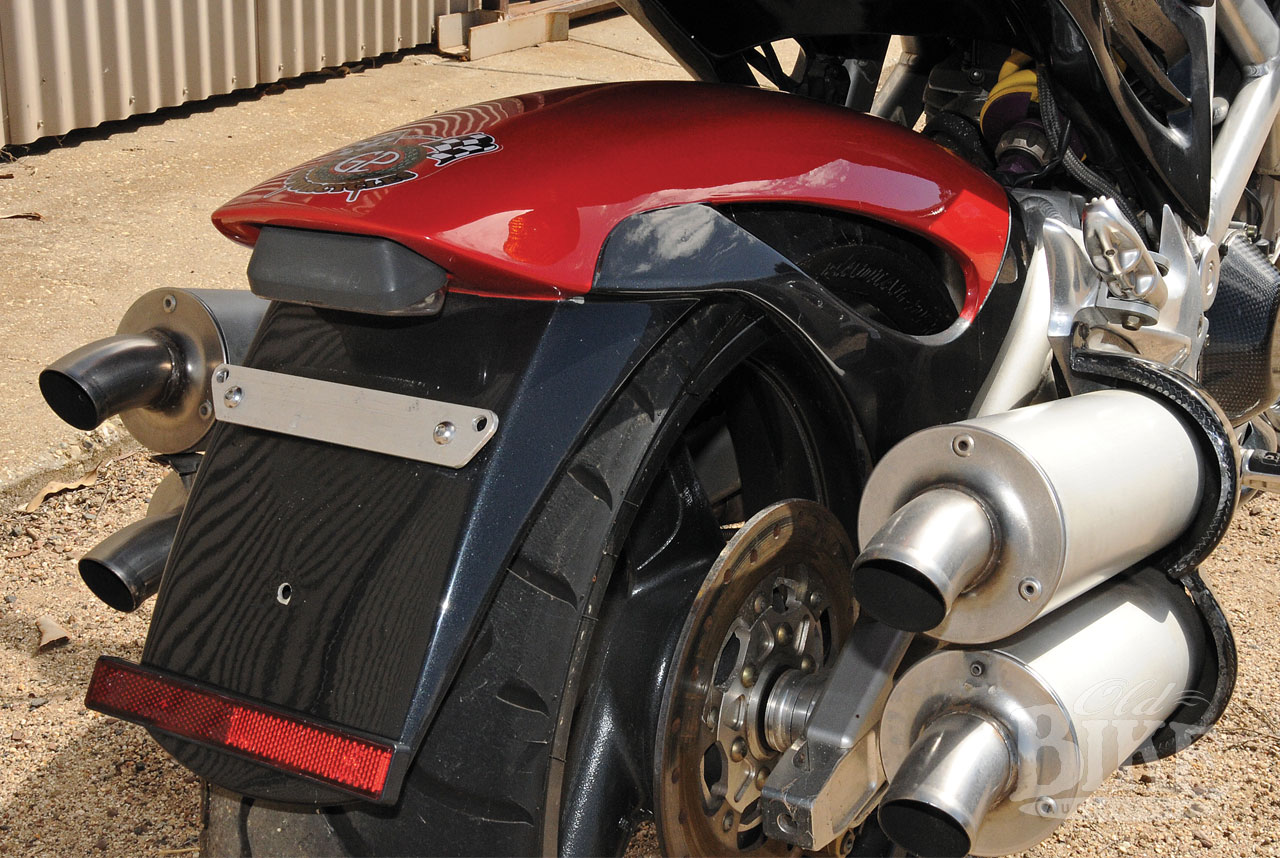
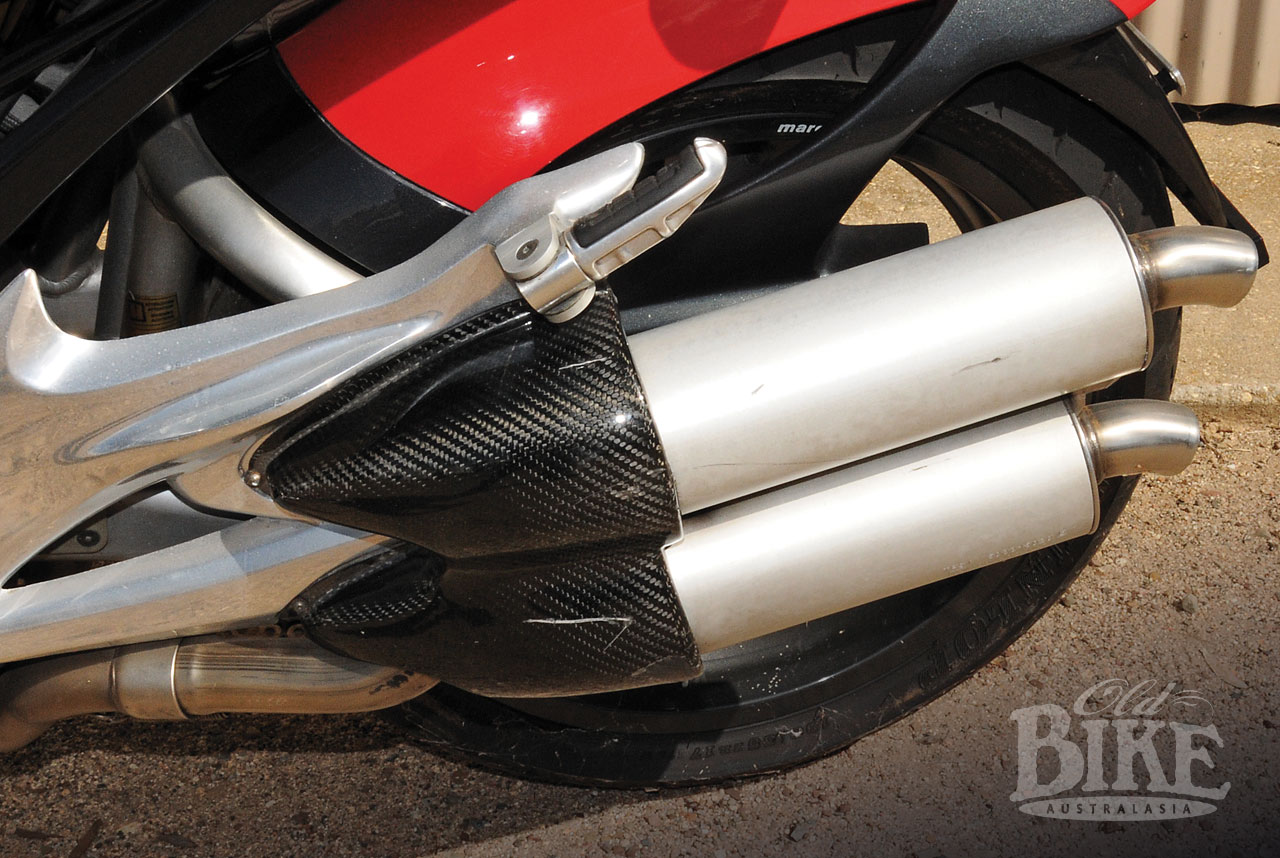
Below the engine sat a wedge-shaped pan that enclosed the front exhaust pipe header and directed air to the rear of the engine. Each of the exhaust pipes split into two at the rear, with twin mufflers and droopy outlets. Given the weight penalty, the use of four mufflers instead of two was questionable, but an immutable part of Lakic’s design exercise. Carbon fibre shields enclosed the front of the mufflers and gave some heat protection for the pillion passenger’s feet. The rear mudguard was of the hugger type, closely fitted around the rear tyre and colour matched to the main cowling. Carbon fibre touches abounded; around the seat, on the front and rear mudguards, and in the lower reaches of the fairing. There was also a carbon fibre clutch cover available as an option.
When it came to production, Lakic was disappointed that some compromises were necessary, such as the substitution of the small front headlight with a much larger unit, sourced from a Yamaha FZR600, in order to more easily satisfy US regulations. The use of twin fuel tanks also made filling somewhat of a chore. The front end of the Cologne display model also came in for some refinement, with the full-floating cast iron discs replaced by semi-floating stainless rotors sourced from Ducati stocks. By late 1995, production was under way, and the first road tests were generally complimentary, especially for the handling, which of course had little relationship to the styling. In fact the vital specs of the chassis; 24 degrees rake/92mm trail and wheelbase of 1370mm, came from the sweet handling DB2, so there was no surprise it did the job very well. The geometry could be altered by lengthening the rear shock for slightly quicker steering. The non-adjustable Paoli front fork came in for some stick, to the point the Bimota soon offered an optional unit with spring preload and adjustable compression damping. While the seat padding looked minimal, it was generally given the thumbs up for comfort, at least for the rider if not for the passenger, and the overall relationship between the seat, handlebars and footrests was deemed quite satisfactory for general riding as well as carving up twists and turns in the country.
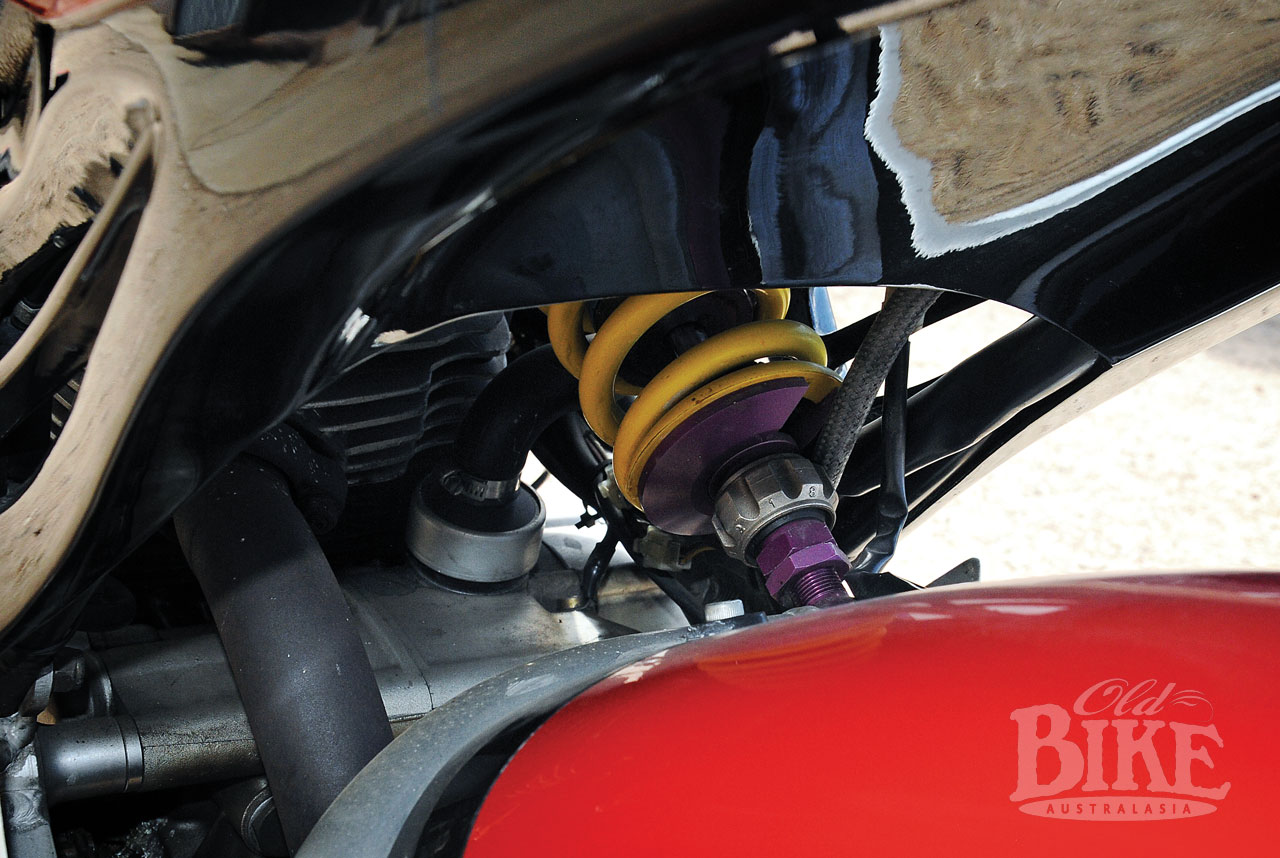
The engine, whilst doing its job reasonably well, copped some flack for its inability to rev, and to run out of puff at the top end, which was put down to the use of the extended inlet mounts that came straight from the 900SS and the Monster, and which maximised low speed torque at the expense of outright power and speed, which topped out at around 200 km/h on a good day. And although the six-speed gearbox drew plenty of praise, the stiff, grabby and noisy dry clutch did not. If there was one universal criticism, it was the price. Invariably, the Mantra was compared to the Ducati 900SS, and after all, much of its componentry originated from Bologna, and the difference, nearly double the price, was difficult to swallow – even more so when the Mantra was compared to the Ducati Monster.
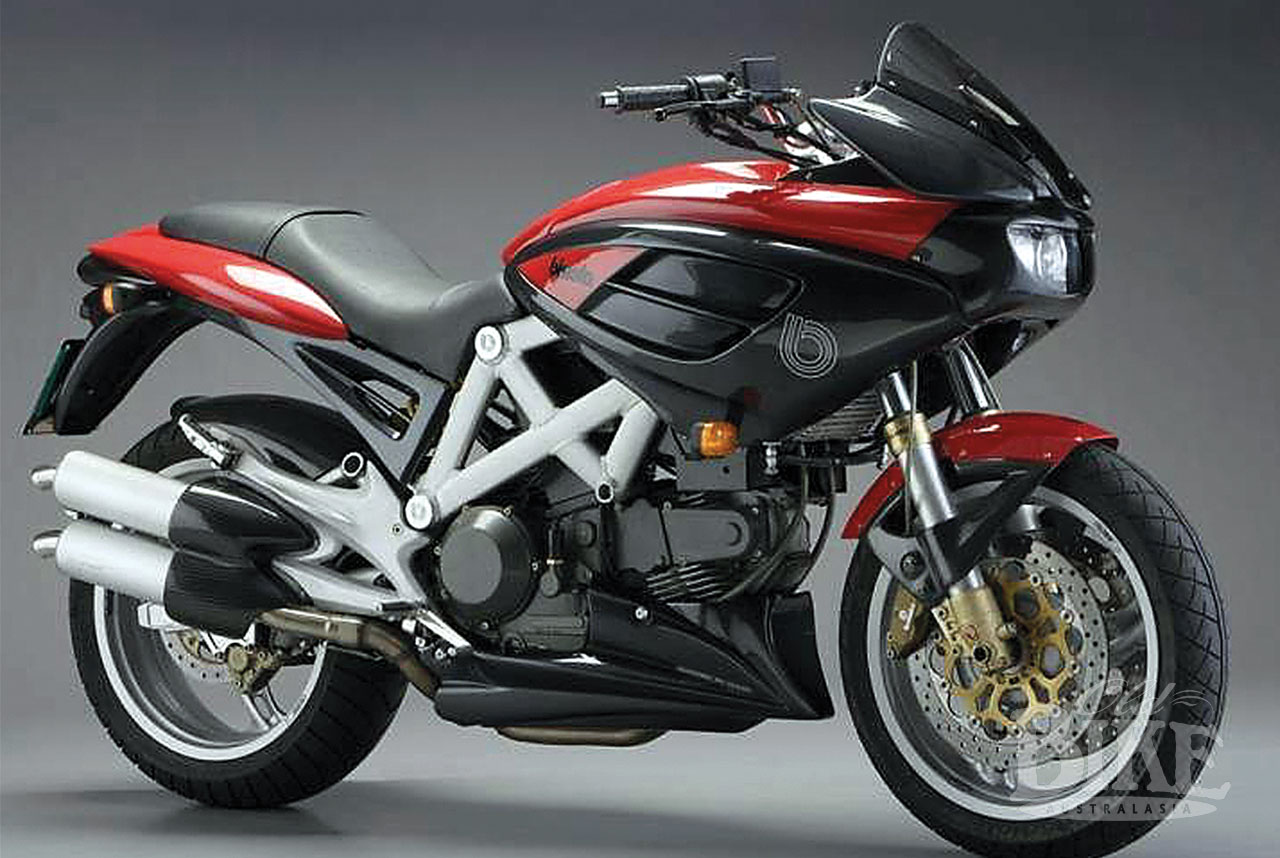
In its original form, the Mantra was produced from 1995 to 1997. The 1998 model was unveiled at the Milan Show in November 1997, featuring minor bodywork revisions and the same engine. Gone were the unusual high-rise clip-on handlebars, replaced with conventional (Monster style) tubular bars, with the original Marchesini wheels replaced by similar Antera items. The rear end and rear tyre hugger were reshaped, and a tinted windshield available. Most of these items could be retro fitted to the earlier model. By the time production concluded in 1998, only 454 had been built, all but 50 of these to the original specification. Still, Bimota proclaimed itself well pleased with this result, given its limited resources and facilities which was also coping with the production of the popular SB6 and the not-so-popular Tesi. After the discontinuation of the Mantra, attention turned to the DB4, which was a similar motorcycle with far less polarising bodywork.
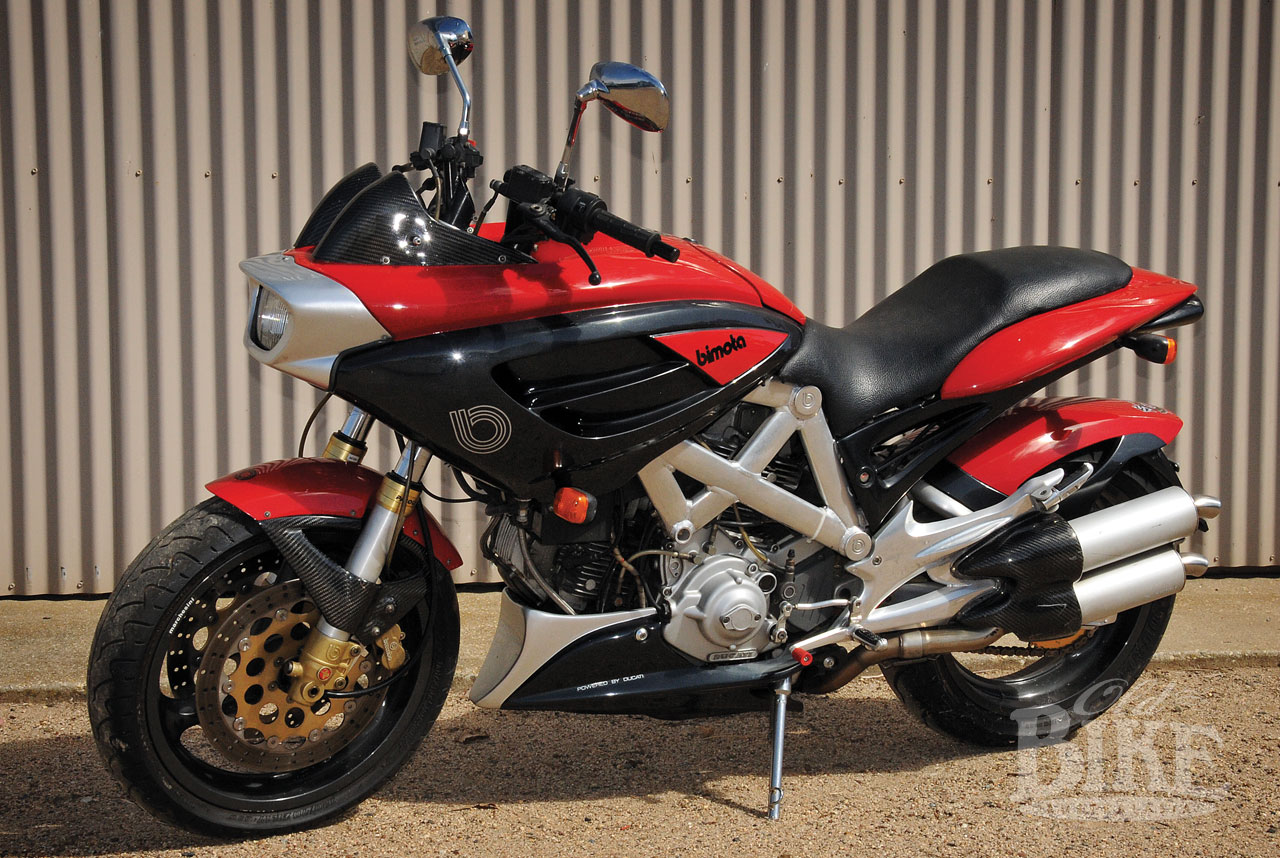
Despite earlier indications, Lakic was not called upon by Bimota for further design work. However he remained unfazed by the Mantra exercise and went on to develop a series of less controversial designs for the French Voxon v-twin motorcycle, as well a number of concepts for Venturi’s electric motorcycles. More recently, he has applied his talents to designing furniture, watches, bicycles, and cars such as the zero-emission Venturi Eclectic.
The Mantra is a rare bird anywhere, and almost mythical Down Under. Originally, just ten came into the country, all in yellow. At $25,500 plus ORC ($8,505 more than the Monster M900 in 1996), you have a fair idea why so few made it here. You will also observe that our featured Mantra is red, which makes it not one of the original ten, and is in fact a 1996 model owned by Italian motorcycle expert and aficionado Ron Angel, who knows more about Bimota (and indeed Ducati, Moto Guzzi, Mondial etc, etc) than just about anyone here or elsewhere. Thanks Ron.
Specifications: 1996 Bimota Mantra
Engine: Air/oil cooled desmo 2 valve, belt driven SOHC.
Bore x stroke: 82mm x 68mm
Capacity: 904cc
Compression ratio: 9.2:1
Ignition: Electronic
Power: 86hp at 7,000 rpm
Torque: 90Nm at 5,500 rpm
Carburation: 2 x Mikuni 38mm
Starting: Electronic
Lubrication: Wet sump.
Transmission: 6-speed, gear primary drive
Clutch: Dry, hydraulically activated.
Chassis: Oval section alloy tube chassis with tubular alloy swinging arm.
Rake: 24 degrees, trail 92mm
Wheelbase: 1370mm
Suspension: Front: 43mm Paioli fork, 120mm travel. Rear: Paioli monoshock 130mm travel
Wheels: Marchesini 3-spoke cast alloy
Tyre sizes: Front: 120/70 ZR17 Rear: 180/55 ZR17
Brakes: Front: 2 x 320mm discs with brembo 4-piston callipers.
Rear: 1 x 230mm disc with Brembo 2-piston calliper.
Weight: 172kg dry
Seat height: 790m
Fuel capacity: 16 litres
Price in Australia (1996): $25,500 + ORC
